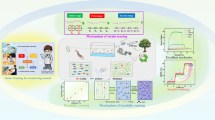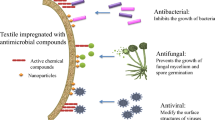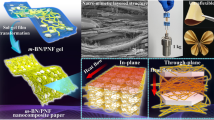Abstract
In this study, functional coatings with N-halamine structure were formed on cotton fabrics by dopamine (DA) auto-deposition and DA/Polyethyleneimine (PEI) covalent co-deposition, respectively. SEM、UV-Vis and XPS had confirmed the deposition of DA and DA/ polydopamine (PDA) on the cotton fabrics. When the mass ratio of DA/PEI was 1:1.5, a uniform functional coating was formed. XRD had indicated that the coating and the oxidative sodium hypochlorite solution did not affect the crystal structure of cellulose. The DA/PEI co-deposited modified cotton fabric had excellent antibacterial property after chlorination, and the inactivation rate against E coli and S aureus could reach 100% with a contact time of 30 min. In vitro cell cytocompatibility studies demonstrated that the DA/PEI co-deposited modified cotton fabric has good biocompatibility. The functional coating on the cotton fabric remained stable after 50 washing cycles. The UPF values and the wrinkle recovery angle (WRA) tests showed that the DA/PEI co-deposited coating imparted great durable press and UV protective properties to the cotton fabric. The breaking strength loss rate of the modified cotton fabrics after chlorination was about 20%, which had little effect on the wearing property.
Graphic abstract














Similar content being viewed by others
References
Ball V (2014) Physicochemical perspective on “polydopamine” and “poly(catecholamine)” films for their applications in biomaterial coatings. Biointerphases 9:030801. https://doi.org/10.1116/1.4875115
Cai X, Li H, Zhang L, Yan J (2021) Dyeing property improvement of madder with Polycarboxylic acid for cotton. Polymers (basel). https://doi.org/10.3390/polym13193289
Cerkez I, Kocer HB, Worley SD, Broughton RM, Huang TS (2011) N-halamine biocidal coatings via a layer-by-layer assembly technique. Langmuir 27:4091–4097. https://doi.org/10.1021/la104923x
Cerkez I, Kocer HB, Worley SD, Broughton RM, Huang TS (2016) Antimicrobial functionalization of poly(ethylene terephthalate) fabrics with waterborne N-halamine epoxides. J Appl Polym Sci 133:43088. https://doi.org/10.1002/app.43088
Cheng D, He M, Ran J, Cai G, Wu J, Wang X (2018) Depositing a flexible substrate of triangular silver nanoplates onto cotton fabrics for sensitive SERS detection. Sensor Actuat B-Chem 270:508–517. https://doi.org/10.1016/j.snb.2018.05.075
Chien H-W, Chiu T-H (2020) Stable N-halamine on polydopamine coating for high antimicrobial efficiency. Eur Polym J. https://doi.org/10.1016/j.eurpolymj.2020.109654
Chien HW, Chen YY, Chen YL, Cheng CH, Lin JC (2019) Studies of PET nonwovens modified by novel antimicrobials configured with both N-halamine and dual quaternary ammonium with different alkyl chain length. RSC Adv 9:7257–7265. https://doi.org/10.1039/c9ra00094a
d’Ischia M, Napolitano A, Pezzella A, Meredith P, Sarna T (2009) Chemical and structural diversity in eumelanins: unexplored bio-optoelectronic materials. Angew Chem Int Edit 48:3914–3921. https://doi.org/10.1002/anie.200803786
Del Frari D, Bour J, Ball V, Toniazzo V, Ruch D (2012) Degradation of polydopamine coatings by sodium hypochlorite: a process depending on the substrate and the film synthesis method. Polym Degrad Stabil 97:1844–1849. https://doi.org/10.1016/j.polymdegradstab.2012.05.002
Dong A, Wang YJ, Gao Y, Gao T, Gao G (2017) Chemical insights into antibacterial N-Halamines. Chem Rev 117:4806–4862. https://doi.org/10.1021/acs.chemrev.6b00687
Gao Y, Dong Q, Lan S, Cai Q, Simalou O et al (2015) Decorating CdTe QD-embedded mesoporous silica nanospheres with Ag NPs to prevent bacteria invasion for enhanced anticounterfeit applications. Acs Appl Mater Inter 7:10022–10033
Gutman O, Natan M, Banin E, Margel S (2014) Characterization and antibacterial properties of N-halamine-derivatized cross-linked polymethacrylamide nanoparticles. Biomaterials 35:5079–5087. https://doi.org/10.1016/j.biomaterials.2014.02.056
Hou C, Qi Z, Zhu H (2015) Preparation of core-shell magnetic polydopamine/alginate biocomposite for Candida rugosa lipase immobilization. Colloid Surface B 128:544–551. https://doi.org/10.1016/j.colsurfb.2015.03.007
Jegal JH, Choi GH, Lee HJ, Kim KD, Lee SC (2015) Surface engineering of titanium with simvastatin-releasing polymer nanoparticles for enhanced osteogenic differentiation. Macromol Res 24:83–89. https://doi.org/10.1007/s13233-016-4007-7
Ju KY, Lee Y, Lee S, Park SB, Lee JK (2011) Bioinspired polymerization of dopamine to generate melanin-like nanoparticles having an excellent free-radical-scavenging property. Biomacromol 12:625–632. https://doi.org/10.1021/bm101281b
Karkhanechi H, Takagi R, Matsuyama H (2014) Biofouling resistance of reverse osmosis membrane modified with polydopamine. Desalination 336:87–96. https://doi.org/10.1016/j.desal.2013.12.033
Kaur R, Liu S (2016) Antibacterial surface design – Contact kill. Prog Surf Sci 91:136–153. https://doi.org/10.1016/j.progsurf.2016.09.001
Kim HW, McCloskey BD, Choi TH, Lee C, Kim MJ, Freeman BD, Park HB (2013) Oxygen concentration control of dopamine-induced high uniformity surface coating chemistry. Acs Appl Mater Inter 5:233–238. https://doi.org/10.1021/am302439g
Lee H, Dellatore SM, Miller WM, Messersmith PB (2007) Mussel-inspired surface chemistry for multifunctional coatings. Science 318:426–430. https://doi.org/10.1126/science.1147241
Li J, Li R, Du J, Ren X, Worley SD, Huang TS (2013) Improved UV stability of antibacterial coatings with N-halamine/TiO2. Cellulose 20:2151–2161. https://doi.org/10.1007/s10570-013-9976-5
Li P, Wang B, Liu YY, Xu YJ, Jiang ZM et al (2020) Fully bio-based coating from chitosan and phytate for fire-safety and antibacterial cotton fabrics. Carbohydr Polym 237:116173. https://doi.org/10.1016/j.carbpol.2020.116173
Li R, Sun M, Jiang Z, Ren X, Huang TS (2014) N-halamine-bonded cotton fabric with antimicrobial and easy-care properties. Fiber Polym 15:234–240. https://doi.org/10.1007/s12221-014-0234-8
Ma W, Li L, Liu Y, Sun Y, Kim IS, Ren X (2019) Tailored assembly of vinylbenzyl N-halamine with end-activated ZnO to form hybrid nanoparticles for quick antibacterial response and enhanced UV stability. J Alloy Compd 797:692–701. https://doi.org/10.1016/j.jallcom.2019.05.174
Nazi N, Humblot V, Debiemme-Chouvy C (2020) A New antibacterial N-Halamine coating based on polydopamine. Langmuir 36:11005–11014. https://doi.org/10.1021/acs.langmuir.0c01856
Nazi N, Marguier A, Debiemme-Chouvy C, Humblot V (2022) Optimization and antibacterial response of n-halamine coatings based on polydopamine. Colloids Interfaces . https://doi.org/10.3390/colloids6010009
Nguyen HN, Nadres ET, Alamani BG, Rodrigues DF (2017) Designing polymeric adhesives for antimicrobial materials: poly(ethylene imine) polymer, graphene, graphene oxide and molybdenum trioxide - a biomimetic approach. J Mater Chem B 5:6616–6628. https://doi.org/10.1039/c7tb00722a
Ponzio F, Ball V (2016) Polydopamine deposition at fluid interfaces. Polym Int 65:1251–1257. https://doi.org/10.1002/pi.5124
Ponzio F, Barthès J, Bour J, Michel M, Bertani P et al (2016) Oxidant control of polydopamine surface chemistry in acids: a mechanism-based entry to superhydrophilic-superoleophobic coatings. Chem Mater 28:4697–4705. https://doi.org/10.1021/acs.chemmater.6b01587
Qiu WZ, Yang HC, Xu ZK (2018) Dopamine-assisted co-deposition: an emerging and promising strategy for surface modification. Adv Colloid Interfac Sci 256:111–125. https://doi.org/10.1016/j.cis.2018.04.011
Su L, Yu Y, Zhao Y, Liang F, Zhang X (2016) Strong Antibacterial polydopamine coatings prepared by a shaking-assisted method. Sci Rep 6:24420. https://doi.org/10.1038/srep24420
Sun X, Cao Z, Porteous N, Sun Y (2012) An N-halamine-based rechargeable antimicrobial and biofilm controlling polyurethane. Acta Biomater 8:1498–1506. https://doi.org/10.1016/j.actbio.2011.12.027
Talukder E, Manikandan N (2016) Optimum concentration of cross-linking agent for crease-resistant finishing using DMDHEU on knit and woven fabric in the field of ease care durable press. Int J Text Sci 5:74–81
Tian Y, Cao Y, Wang Y, Yang W, Feng J (2013) Realizing ultrahigh modulus and high strength of macroscopic graphene oxide papers through crosslinking of mussel-inspired polymers. Adv Mater 25:2980–2983. https://doi.org/10.1002/adma.201300118
Wei H, Ren J, Han B, Xu L, Han L, Jia L (2013) Stability of polydopamine and poly(DOPA) melanin-like films on the surface of polymer membranes under strongly acidic and alkaline conditions. Colloids Surf B 110:22–28. https://doi.org/10.1016/j.colsurfb.2013.04.008
Yang H-C, Liao K-J, Huang H, Wu Q-Y, Wan L-S, Xu Z-K (2014) Mussel-inspired modification of a polymer membrane for ultra-high water permeability and oil-in-water emulsion separation. J Mater Chem A 2:10225–10230. https://doi.org/10.1039/c4ta00143e
Yang H-C, Wu M-B, Li Y-J, Chen Y-F, Wan L-S, Xu Z-K (2016) Effects of polyethyleneimine molecular weight and proportion on the membrane hydrophilization by codepositing with dopamine. J Appl Polym Sci. https://doi.org/10.1002/app.43792
Zeng T, Zhang X, Niu H-y, Ma Y-r, Li W-h, Cai Y-q (2013) In situ growth of gold nanoparticles onto polydopamine-encapsulated magnetic microspheres for catalytic reduction of nitrobenzene. Appl Catal B-Environ 134–135:26–33. https://doi.org/10.1016/j.apcatb.2012.12.037
Zhang C, Ou Y, Lei WX, Wan LS, Ji J, Xu ZK (2016) CuSO4/H2O2-induced rapid deposition of polydopamine coatings with high uniformity and enhanced stability. Angew Chem Int Ed Engl 55:3054–3057. https://doi.org/10.1002/anie.201510724
Zhang Y, Chen S, An J, Fu H, Wu X, Pang C, Gao H (2019) Construction of an antibacterial membrane based on dopamine and polyethylenimine cross-linked graphene oxide. ACS Biomater Sci Eng 5:2732–2739. https://doi.org/10.1021/acsbiomaterials.9b00061
Zhao C, Zuo F, Liao Z, Qin Z, Du S, Zhao Z (2015) Mussel-inspired one-pot synthesis of a fluorescent and water-soluble polydopamine-polyethyleneimine copolymer. Macromol Rapid Commun 36:909–915. https://doi.org/10.1002/marc.201500021
Zhou S, Wang W, Sun Y, Tang X, Zhang B, Yao X (2021) Antibacterial effect of Ag-PMANa modified cotton. Colloid Surf A. https://doi.org/10.1016/j.colsurfa.2021.126453
Funding
We are grateful to the scientific research funding project of the “Five Strategies” of Education Service of Industrial Technology Research Institute of Liaoning Universities (No.2018LY027).
Author information
Authors and Affiliations
Contributions
Jiansheng Wan, Hong Li, and Jun Yan designed the experiments and referenced conception. Xiaoyu Cai and Yongping Liao participated in the experiments. Jiansheng Wan analyzed the data. Jiansheng Wan, Hong Li, and Xiaoyu Cai wrote the paper. All authors had read and agreed to the published version of the manuscript.
Corresponding author
Ethics declarations
Conflict of interest
The authors have no conflicts of interest to declare.
Additional information
Publisher's Note
Springer Nature remains neutral with regard to jurisdictional claims in published maps and institutional affiliations.
Rights and permissions
Springer Nature or its licensor holds exclusive rights to this article under a publishing agreement with the author(s) or other rightsholder(s); author self-archiving of the accepted manuscript version of this article is solely governed by the terms of such publishing agreement and applicable law.
About this article
Cite this article
Wan, J., Li, H., Cai, X. et al. Developing the functional cotton fabric with N-halamine antibacterial structure based on DA/PEI. Cellulose 29, 9953–9967 (2022). https://doi.org/10.1007/s10570-022-04876-0
Received:
Accepted:
Published:
Issue Date:
DOI: https://doi.org/10.1007/s10570-022-04876-0




